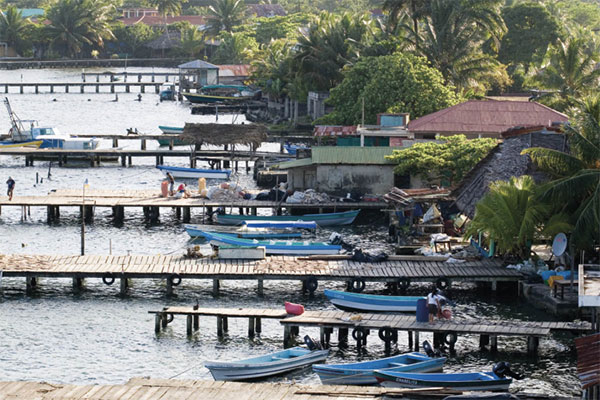Fact
Boat cruises around El Golfete (usually departing from Livingston) often stop at the hot springs that empty into the lagoon, so you can take a dip in the warm, sulfurous water. It is an idyllic spot, shaded by overhanging trees and surrounded by lush jungle vegetation.
Puerto Barrios
Puerto Barrios # [map] , in the southeastern corner of Bahía de Amatique, is today little more than a transit point for tourists picking up boats for Punta Gorda in Belize or en route for Livingston. For many years, though, the town was the country’s most important port. Now it has been eclipsed by the modern facilities available at Santo Tomás de Castilla, just 11km (7 miles) to the west around the bay.
Puerto Barrios was established by President Rufino Barrios in the late 19th century, but developed by the United Fruit Company in the 1900s as the company’s exclusive port for the export of its bananas. The UFC modeled the town on urban North American lines, and it retains this legacy today, with broad streets and sprawling city blocks.
Most of the old wooden Caribbean buildings are crumbling and dilapidated now, unfortunately, replaced by faceless concrete constructions. The odd reminder of more prosperous times remains, however, and the town’s one real sight is the atmospheric Hotel del Norte, right on the waterfront, an immaculately preserved – and charming – living monument, built entirely from wood.
The Petén
Hidden in this vast northern jungle department are some of the most spectacular Maya cities, including the indisputable, dazzling jewel in their crown: Tikal.
Between 750 BC and around AD 900, the Maya civilization – arguably the greatest of all pre-Columbian cultures – evolved, excelled, and ultimately collapsed in the lowland subtropical forests of what is now northern Guatemala. It was in the jungles and savannas of the department of Petén, which covers a third of the country that the Maya city-states succeeded in creating some of the greatest human advances on the continent: a precise calendrical system, pioneering astronomy, a complex writing system, breathtaking artistry, and towering architectural triumphs.

The fishing docks at Livingston.
Corrie Wingate/Apa Publications
There’s compelling evidence that a combination of environmental and social factors (including overpopulation, warfare, and revolt) prompted the disaster of the Maya collapse, but the exact reasons are still subject to animated academic debate. Whatever the truth, the jungle reclaimed the temples, plazas, and palaces, so that by the time the 19th century explorers arrived, buildings were choked with over 1,000 years of forest growth.
The Petén is still Guatemala’s wild frontier province, and transportation, communications, hotels, and restaurants are generally pretty basic away from the main town of Flores. To get to Maya sites like El Mirador takes time (unless you take a heli-tour!), planning, and local expertise – there are a number of excellent local organizations that operate expeditions to the remote ruins. The Petén climate is perennially hot and humid. The rainy season can extend until December, and can disrupt overland travel to isolated areas. Tikal and Flores are always accessible nevertheless.
Flores
Set on a natural island in Lago de Petén Itzá, connected via a small causeway to shore, Flores ¢ [map] , is a peaceful, civilized place now largely dependent on tourism. It is a small, tranquil, and historic town that’s by far the most pleasant urban center in the department. Today’s town stands on the remains of the old Itzá Maya capital, Tayasal, which was first visited by Hernán Cortés in 1525, left alone, and only conquered in 1697. The Spanish had no appetite for jungle life, and Flores retained closer contact with Belize and Mexico until the road links to the rest of Guatemala improved in the late 20th century.
Where
For more than half a century, all Guatemala’s political and economic decisions were effectively supervised by the United Fruit Company, Central America’s biggest employer, and dubbed El Pulpo (“The Octopus”) because of its huge influence in the region. The UFC first began banana business in Guatemala in 1901, and quickly struck a deal to complete the Guatemala City–Puerto Barrios railroad track in exchange for almost complete tax exemption and land concessions. By 1930 the company was worth US$215 million, and its yellow tentacles controlled the country’s railroads, the main port Puerto Barrios, and consequently had control over all the country’s other exports.
This hegemony was largely unchecked until 1952, when President Jacobo Árbenz Guzman drafted new reform laws, which redistributed land to disadvantaged farming communities at a fraction of its market value. US interests were deemed to be under threat, and a plot was hatched by the CIA (whose director Allen Dulles was also on the UFC board) to support an invading force of Guatemalan exiles from Honduras, which overthrew Árbenz in 1954. The new CIA-backed strongman, Carlos Castillo Armas, returned all the confiscated land to the UFC, which merged with United Brands in the 1960s and finally quit Guatemala in 1972, selling its remaining land to Del Monte.
The best way to explore Flores is to stroll around the lane that circumscribes the shoreline – it will take you about 15 minutes to walk around the cobblestone streets and lanes of the town. Some of its architecture is delightful: the older houses are brightly painted wooden and adobe constructions, many of the hotels have been painted in harmonious pastel shades, and there’s a fine plaza in the center of town that boasts a twin-domed cathedral.
Just across the causeway, the gritty urban sprawl of Santa Elena and San Benito could not present more of a contrast. These are rough and ready frontier towns, where the streets are thick with dust and dirt.